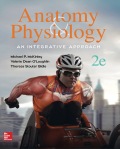
Anatomy & Physiology: An Integrative Approach
2nd Edition
ISBN: 9781259124075
Author: McKinley
Publisher: MCG
expand_more
expand_more
format_list_bulleted
Concept explainers
Question
Chapter 9.7, Problem 17WDYL
Summary Introduction
To determine:
The movements that are allowed at the temporomandibular joint.
Concept introduction:
Joints are defined as the connection between bones and the skeletal system. There are six types of joints that are found in different positions of the body such as synovial joint, pivot joint, saddle joint, condyloid joint, hinge joint, ball and socket joint, and plane joint.
Expert Solution & Answer
Want to see the full answer?
Check out a sample textbook solution
Students have asked these similar questions
What are the four major categories of movements that occur atsynovial joints?
What type of movements are possible with the knee joint?
Which fibrous joints are synarthroses? Which are amphiarthroses?
Chapter 9 Solutions
Anatomy & Physiology: An Integrative Approach
Ch. 9.1 - What is the relationship between mobility and...Ch. 9.1 - Are all fibrous joints also synarthroses? Explain...Ch. 9.2 - Prob. 3WDYLCh. 9.2 - Prob. 4WDYLCh. 9.2 - Prob. 5WDYLCh. 9.3 - Prob. 6WDYLCh. 9.3 - Prob. 7WDYLCh. 9.4 - What are the basic characteristics of all types of...Ch. 9.4 - Prob. 9WDYLCh. 9.4 - Prob. 10WDYL
Ch. 9.5 - What is the difference between the effort arm and...Ch. 9.5 - Prob. 12WDYLCh. 9.6 - Prob. 13WDYLCh. 9.6 - How do flexion and extension differ? What...Ch. 9.6 - Prob. 15WDYLCh. 9.6 - Prob. 16WDYLCh. 9.7 - Prob. 17WDYLCh. 9.7 - Prob. 18WDYLCh. 9.7 - Prob. 19WDYLCh. 9.7 - How do the glenohumeral and hip joints compare...Ch. 9.7 - What are the functions of each of the...Ch. 9.7 - Prob. 22WDYLCh. 9.8 - Prob. 23WDYLCh. 9 - _____ 1. The greatest range of mobility of any...Ch. 9 - _____ 2. A movement of the foot that turns the...Ch. 9 - _____ 3. A _______ is formed when two bones...Ch. 9 - Prob. 4DYKBCh. 9 - Prob. 5DYKBCh. 9 - Prob. 6DYKBCh. 9 - Prob. 7DYKBCh. 9 - Prob. 8DYKBCh. 9 - Prob. 9DYKBCh. 9 - Prob. 10DYKBCh. 9 - Prob. 11DYKBCh. 9 - Prob. 12DYKBCh. 9 - List and describe all joints that are functionally...Ch. 9 - How do a hinge joint and a pivot joint compare...Ch. 9 - Prob. 15DYKBCh. 9 - Prob. 16DYKBCh. 9 - Most ankle sprains are overinversion injuries....Ch. 9 - What are the main supporting ligaments of the...Ch. 9 - Prob. 19DYKBCh. 9 - What are the similarities and differences between...Ch. 9 - Prob. 1CALCh. 9 - Prob. 2CALCh. 9 - Prob. 3CALCh. 9 - Prob. 4CALCh. 9 - Prob. 5CALCh. 9 - During soccer practice, Erin tripped over the...Ch. 9 - Prob. 2CSLCh. 9 - Jackie visits her physician because she is...
Knowledge Booster
Learn more about
Need a deep-dive on the concept behind this application? Look no further. Learn more about this topic, biology and related others by exploring similar questions and additional content below.Similar questions
arrow_back_ios
arrow_forward_ios
Recommended textbooks for you
 Fundamentals of Sectional Anatomy: An Imaging App...BiologyISBN:9781133960867Author:Denise L. LazoPublisher:Cengage Learning
Fundamentals of Sectional Anatomy: An Imaging App...BiologyISBN:9781133960867Author:Denise L. LazoPublisher:Cengage Learning

Fundamentals of Sectional Anatomy: An Imaging App...
Biology
ISBN:9781133960867
Author:Denise L. Lazo
Publisher:Cengage Learning
Chapter 7 - Human Movement Science; Author: Dr. Jeff Williams;https://www.youtube.com/watch?v=LlqElkn4PA4;License: Standard youtube license